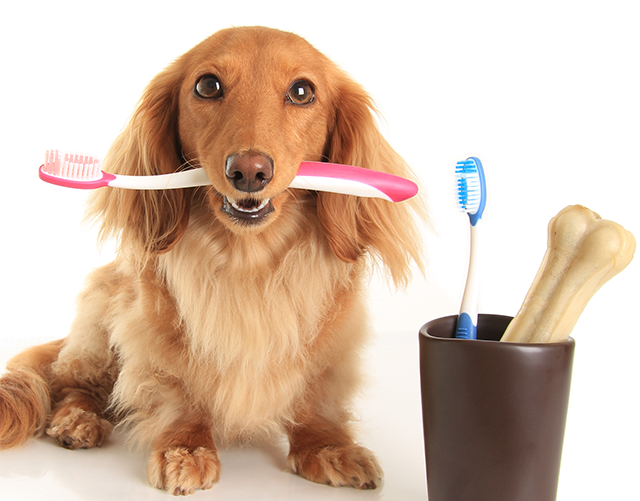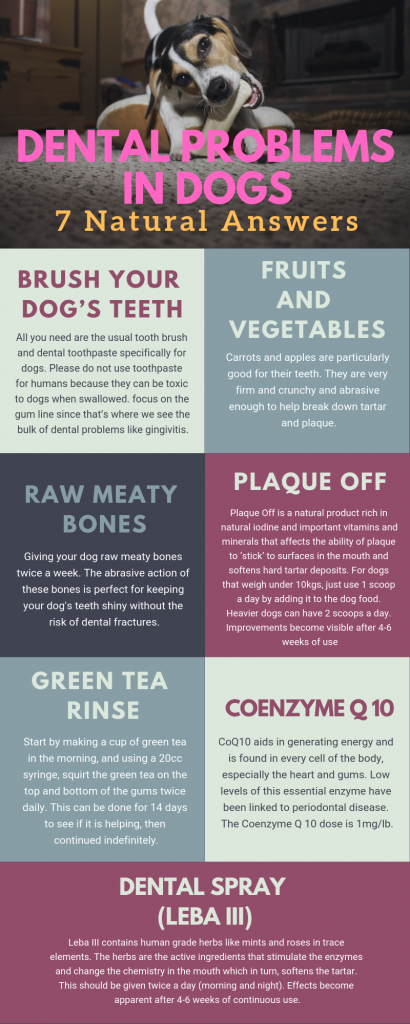7 Remedies for Dental Problems in Dogs
Bad breath in dogs may be common but it could be a symptom of more severe dental problems. Plaque, gingivitis, periodontitis and loss of tooth are common dental problems and these may lead to other more serious health issues in your dog when left unattended. Good thing, you don’t have to spend much to address these problems. There are natural remedies you can administer at home.

Brush your dog’s teeth
Dental problems are connected to dental hygiene. And just like humans, dog’s pearly whites need some brushing too. All you need are the usual tooth brush and dental toothpaste specifically for dogs. Another great alternative for dog toothpaste is baking soda. Please do not use toothpaste for humans because they can be toxic to dogs when swallowed. When brushing your dog’s teeth, focus on the gum line since that’s where we see the bulk of dental problems like gingivitis.
Fruits and vegetables
This remedy is something your mom must have told you to eat more. Fruits and vegetables are nutritious and great for humans and also for dogs. Carrots and apples are particularly good for their teeth. They are very firm and crunchy and abrasive enough to help break down tartar and plaque.
Raw meaty bones
Giving your dog raw meaty bones twice a week do not just make them happy but at the same time help you save money. The abrasive action of these bones is perfect for keeping your dog’s teeth shiny without the risk of dental fractures.
Plaque off
Plaque off is a natural product suitable for both cats and dogs. It is rich in natural iodine and contains important vitamins and minerals and is free from artificial colors, preservatives, gluten and sugar. It’s an effective plaque control as it affects the ability of plaque to ‘stick’ to surfaces in the mouth and softens hard tartar deposits. For dogs that weigh under 10kgs, just use 1 scoop a day by adding it to the dog food. Heavier dogs can have 2 scoops a day. Improvements become visible after 4-6 weeks of use. .
Dental Spray (Leba lll)
Dental sprays, specifically Leba lll, are great and safe for dogs. It contains herbs like mints and roses in trace elements, stabilized in Ethyl alcohol 25% and distilled water. All these ingredients are human grade. The herbs are the active ingredients that stimulate the enzymes and change the chemistry in the mouth which in turn, softens the tartar. This should be given twice a day (morning and night). Effects become apparent after 4-6 weeks of continuous use.
Coenzyme Q 10
CoQ10 aids in generating energy. It is found in every cell of the body, especially the heart and gums. Low levels of this essential enzyme have been linked to periodontal disease. In one study a periodontal specialist discovered that people with diseased gums had an unusually large deficiency of coenzyme Q-10. This is also very applicable to pets with serious recurring gingivitis. The Coenzyme Q 10 dose is 1mg for every 1 pound of body weight.
Green Tea Rinse
Lastly, do not forget about some simple and easy natural ways to decrease plaque, gum inflammation and bad breath with the use of a Green Tea Rinse- plus if your dog swallows some it is OK! Start by making a cup of green tea in the morning, and using a 20cc syringe, squirt the green tea on the top and bottom of the gums twice daily. This can be done for 14 days to see if it is helping then, continue indefinitely.

Is there anything else to try if you have tried pretty much all of your suggestions? I have read digestive enzymes help remove Tatar and plaque, but I am not sure if it is correct.
I have two very tiny chihuahuas who will not really chew raw bones or any bones for that matter (they eat dehydrated raw food). We use plaque off, Leba we have tried Dr. Judy’s dental spray and are currently also trying Life Force Oral Care (great ingredients). My biggest chihuahua (4lbs) has also had two anesthetic free dentals. My tiny one would not tolerate that at all (she also gets extremely stressed at the vets since she was spayed..had to wait till she was much older due to waiting for her to weigh enough & since then becomes so stressed at the vets …).
All this to say, I am trying to avoid having to put them under, but no matter what I do/try the tatar keeps coming back. The smallest one’s teeth are getting worse even with all of our efforts . It is hard to get the toothbrush in her very tiny mouth though. Is there anything else I could possibly try or add to what we are doing/trying?
Thanks so very much! I look forward to hearing from you.
Did you ever get a response?
Florence’s post was from quite a while ago, we are trying to reply to as many comments as we can now, but some of the older comments won’t have replies.
Dr. Jones has formulated a new (unique) dental probiotic, we’re hoping to have that available on our store within the next 4-6 weeks.
Have you tried to play a game of tug with braided jute rope.
It is good for the dogs teeth.
Also good to teach them the release command as you play. ?